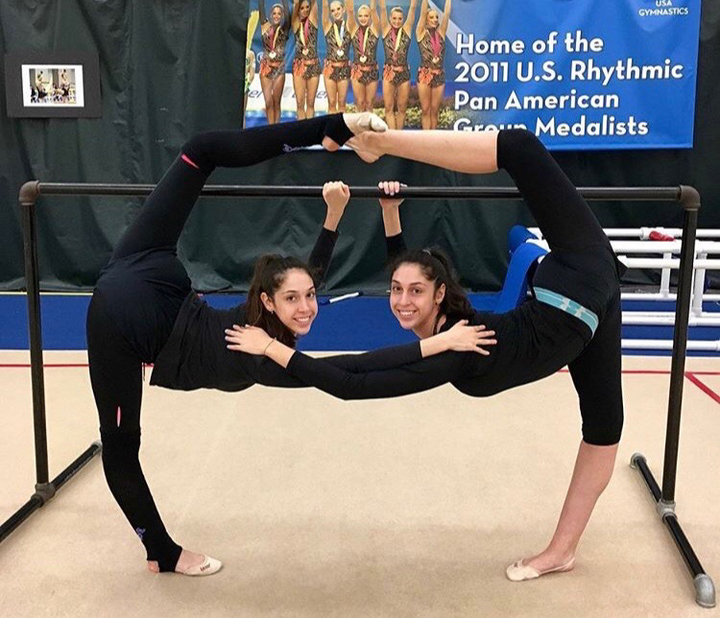The Rokhman sisters: twins, students, Olympians
Jan 22, 2018
At first glance, Monica and Jenny Rokhman might fool you. They are identical twins after all.
There is more to them, though. They look like normal University students. You wouldn’t guess that they are retired Olympians.
From an early age, the Rokhmans were full of energy, and they put it to good use. They found a passion for gymnastics and dedicated themselves to becoming prodigies.
“We were always so active, even when we were babies,” Jenny Rokhman said. “I taught (Monica) how to crawl out of a crib.”
Specializing in rhythmic gymnastics — which relies on synchronization, tosses and acrobatic movements rather than the traditional five events of artistic gymnastics — the pair excelled and drew the attention of USA Gymnastics.
Get The Daily Illini in your inbox!
To maximize their chances at making the national team, they were advised by USA Gymnastics to move to the Chicago area to New York, where some of the top gyms are located.
Monica and Jenny moved to Northbrook, Illinois, where they trained at North Shore Rhythmics. Their mom had to stay in their native California because of her job, so their dad made the move with them.
By age 12, they had become accomplished gymnasts, traveling internationally to countries like Bulgaria and France to compete at the highest level. When high school came around, their focus became even more intense. Missing weeks or even a month of class at a time while attending Glenbrook North became the norm, and it was tough to keep up with their studies and training schedule.
“No one really understood how much we were going through and what we were actually doing,” Monica said. “One time, we missed a whole month of school and I was still trying to find my classes and know my teachers (after everyone else).”
Training took priority over a lot, though their mother always insisted they put school first if they were to be allowed to practice.
However, the price of success at the highest level also came with a heavy social toll.
“We never hung out with our friends; they stopped asking because we were always at practice,” Jenny said.
Not only were the Rokhman sisters in a different lane from their peers at home, they also had very different experiences compared with other gymnasts internationally. Rhythmic gymnastics is a lot more popular in some other countries, in which many accomplished rhythmic gymnasts become stars.
“People from other countries are like, ‘You go to school?’ And I’m like, ‘Yeah, we have to get careers after this,’” Monica said.
Despite their split time, the sisters’ excellence paid off. They were part of the first-ever American rhythmic gymnastics squad to qualify for the Olympics, and in 2016 they represented the U.S. in Rio de Janeiro.
After the team qualified, practices had to ramp up in intensity. The sisters decided to delay the start of their college educations to allocate all the time they needed into being as ready as possible for their big moment.
The team would practice every day, with their sessions regularly exceeding eight hours. Practice would begin with conditioning, which meant running on a treadmill for about 20 minutes. They would then move to floor exercises, which Jenny said were similar to pilates, but much more intense. Then they’d work on kicks, jumps and passes, before finally repeating their routines until virtual perfection was achieved.
The day would break for a meal and icing before heading back to the floor for more practice, and sometimes to work on alternate routines. It would conclude with more conditioning and then finally, physical therapy after practice.
“Everything you do is for the sport,” Jenny said. “Everything you put into your body, how much sleep you get, what you do in your free time, how much time you spend on your phone.”
Living as professional athletes was demanding and exhausting, but it was better with each other’s presence, each twin noted. Though their sisterly bickering was noticeable within just a short conversation with them, it is clear the Rokhmans have a strong bond with each other.
Through trials including international travel, frequently being away from home and vigorous training schedules that required strict discipline, being together was a strength the pair frequently relied on. Sometimes, though, being sisters and teammates did come with challenges.
“It was cool being twins on the team because we moved similarly and did elements the same, but it was definitely hard at times because we would expect more of each other,” Jenny said.
Both Jenny and Monica are grateful for the opportunities the sport has given them, and it has prepared them for the rigors of actual life.
“It’s definitely made us who we are today,” Monica said. “All the traits we have are because of the sport. It taught us to leave our problems outside the gym.”
Fast forward to the present, where the Rokhmans are both studying kinesiology at the University. Believe it or not, their schedules mirror each other exactly. In fact, the twins have a reputation of always being together, from going to class to hanging out with friends.
Jenny laughingly recounted one occasion when she was stopped by a friend because she was not with Monica.
“My friend saw me walking by myself and he was like, ‘Oh my God you’re walking by yourself, I don’t think I’ve ever seen you without your twin by your side,’” Jenny said.
Though they still coach younger gymnasts part-time, things are different nowadays for the Rokhmans. They’re both members of the same sorority, Phi Sigma Sigma, and they make every effort to live out their post-Olympic days as normal college kids.
One thing is certain, though: They will be taking it on together.






